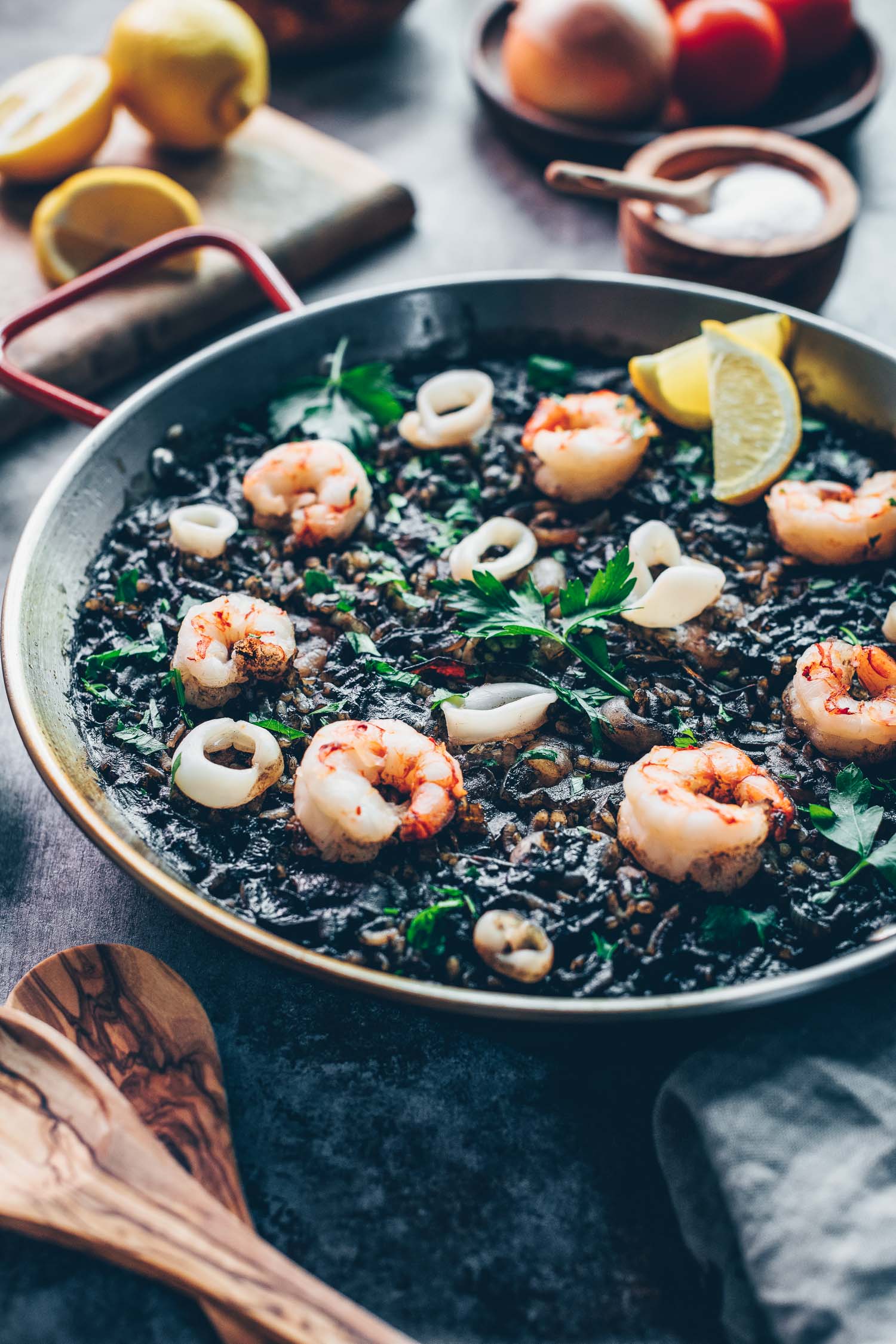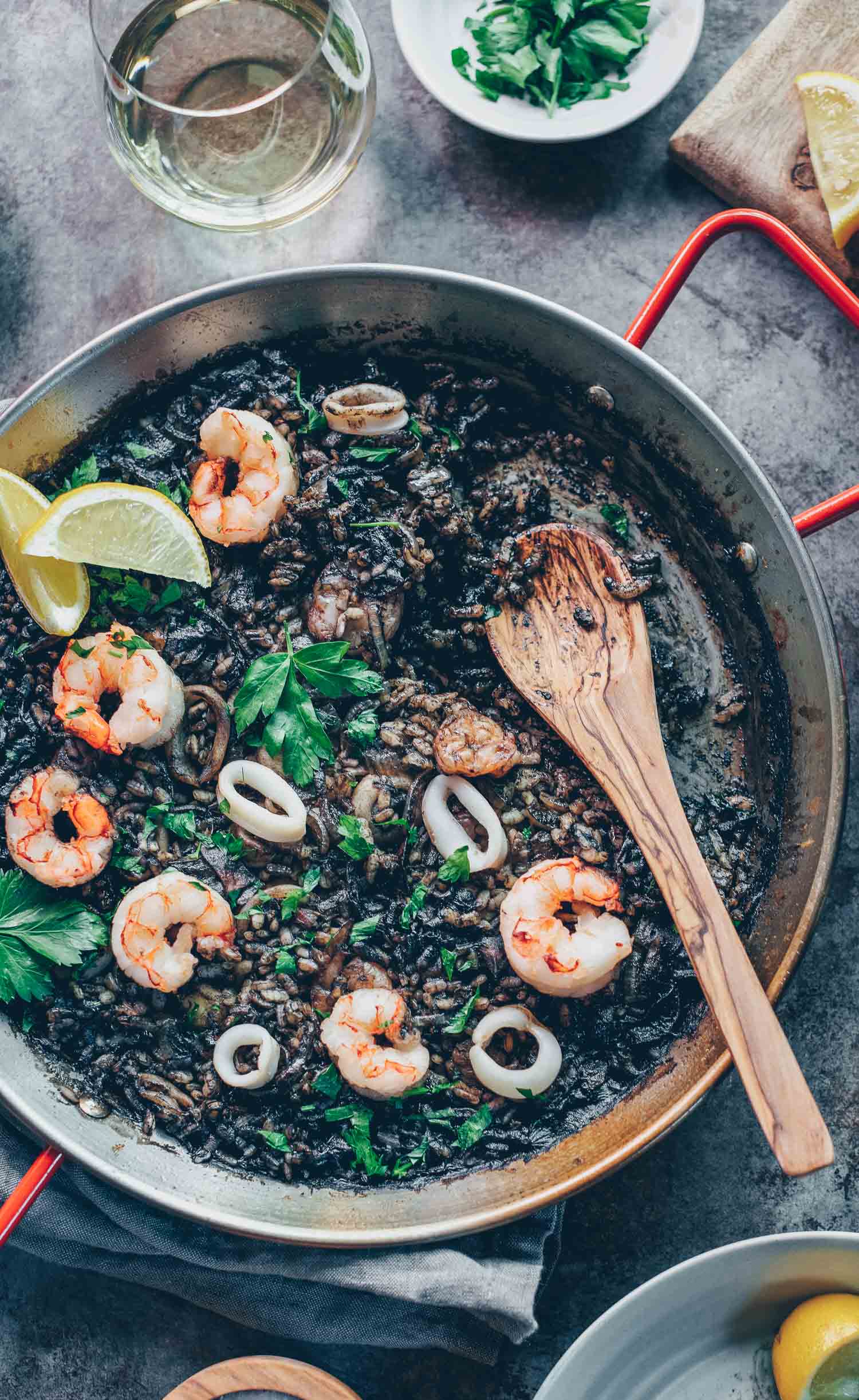Arròs Negre
It seems you either love squid ink or you don’t. If you’re in the former camp this arròs negre, loaded with shrimp and calamari, could just become your go-to recipe.

At a dinner party recently, encouraged by our friend’s casual, relaxed entertaining style, this reluctant hostess (*raising my hand*) declared that she would host a paella party soon. The following day I realized what I had committed to.
See, at the thought of being in charge of feeding a crowd, panic wells up inside me. Four to six people, no problem. More than that and I begin to worry. It’s silly because the gatherings we’ve hosted in the past seem to have been well-received and everyone leaves stuffed (because I tend to double or triple the food-to-guest ratio). The stress comes from trying to figure out what to serve for the main course–will everyone like this or that? What dietary restrictions must I consider?
I know I’ve inherited the entertaining anxiety gene from my mom and for years I’ve tried to conquer it by making a point to commit to having people over, to not overthink the matter. Looking back on gatherings I’ve attended, they’ve not always been perfectly executed but the hosts never lost sleep over the hiccups–so why do I worry so much? Apparently, my subconscious decided it was time for another dose of entertaining therapy.
Paella party it will be.

Really, this party should be fun. It will be a paella cook-off of sorts–not for judging each other’s skills (though there might be some of that made in jest) but mainly to distribute the labor. There are paella “specialists” in the group so we’ll prepare a few in my kitchen and sample different flavor combinations. For the two paellas I plan to prepare, the first will either be my Fideuà, a noodle version of paella, or this Vegetable Paella I shared recently.
The second one will be this squid ink paella. Not everyone will be a fan but I hope to convince the one or two naysayers in the group to learn to enjoy this sepia-rich dish, an ingredient that seems as divisive as anchovies. My squid-ink-averse husband became a convert with this recipe and I hope to attract more to my camp at the party.

Paella vs Arròs Negre
If you’re a fan and have searched recipes online you will have noticed the multiple aliases for the dish–squid ink paella, paella negra and arròs negre. The first is what much of the English-speaking world calls it, the second is what much of Spain calls it but in Valencia (Catalunya region) where this dish originated, the proper term is Arròs Negre (Valencian dialect; literal translation, black rice). In fact, Valencians would not call this paella at all even though it’s prepared in much the same way.

Similarities and Differences
I would venture to say that only a Valencian might frown at us calling this paella (when my husband and I traveled from Barcelona to the tip of the Valencian coastline no one corrected me when I used the term paella negra). The cooking vessel, method and most ingredients are the same between paella and arròs negre, the key difference being the squid ink. Others might also point out that because of the ink, socarrat, the coveted crispy rice at the bottom of the pan in paella, is usually absent from this dish.
Traditional Arròs Negre
Like most paellas, arròs negre is prepared simply with just a handful of ingredients. It starts with a sofrito of garlic, onion and tomato, followed by the briny, umami-rich squid ink and seafood stock with shrimp and calamari as the main proteins. My version here embraces tradition for the most part but this dish can be adapted for your favorite seafood–scallops, crab, mussels, clams.

Variations
Some recipes use paprika and/or bell peppers and others omit both. Spanish smoked paprika is a key ingredient in my paellas so it’s used here, too. I had originally planned to include a red bell pepper but at the last minute I was inspired to substitute hot red pepper paste instead. The paste added a good layer of flavor and a nice little kick.
In the Alicante region a mildly spicy sauce called salmoretta is sometimes used in paellas and arròs negre. Made with olive oil, garlic, tomato, parsley and the region’s native ñora peppers, the ingredients are cooked in a pan, blended then added to the dish. Besides a little heat, salmoretta is meant to add a mild smokiness to rice dishes and I’m not sure if it is used in lieu of or in addition to smoked paprika.
During our travels it was common for us to see paella–both traditional and squid ink–served with alioli. Alioli is a garlicky olive oil mayo that serves as a dip for potatoes and certain rice dishes, arròs negre included. I love aioli for certain foods but it’s not something I would need to complete this dish.

The plan is to have this paella party before Christmas and with travel plans, holiday parties and other commitments I’m hoping we can secure a date before the first half of December. Am I anxious? A little. The main course decided and the responsibility divided I’m not as nervous as I normally would be. Besides, my friends make great guests and deep down I know my stress is unfounded.
How to Eat Paella/Arròs Negre
One thing I might need to do is pick up more of these little olive wood spoons. Did you know that paella is traditionally eaten straight out of the paella pan with a wooden spoon? I’ll be just a tad short for my party of eight but with the wine flowing and laughter abounding, my wooden spoon shortage will hopefully pass unnoticed.
Where to Get Squid Ink
You can harvest the ink from a squid yourself but easiest thing to do is to buy it. They are not available locally here in the Bay Area so I order squid ink online. I have ordered both on Amazon and LaTienda.com (where I also get my paella pans).
Squid ink is sold in jars or in small packets. To give you an idea, this recipe for two used five packets (at four grams each, about 1 tablespoon). This option would make more sense if squid ink is not something you see using all the time. However, buying in jars would be more economical and you can freeze the ink in smaller portions.
Lastly, when you shop for squid ink what you’ll most likely find is cuttlefish ink and this is perfectly okay.
Here are related recipes you might enjoy:
- Vegetable Paella with Shiitake Bacon – this post includes tips for preparing a winning paella each time.
- Fideuà – Noodle-based paella
- Homemade Squid Ink Pasta with Bottarga
- Squid Ink Spaghetti with Shrimp and White Truffle Oil

Arròs Negre (Paella Negra/Squid Ink Paella)
You either love squid ink or you don't. If you're in the first camp this arròs negre, loaded with shrimp and calamari, could just become your go-to recipe.
Ingredients
- 1 small onion, diced
- 2 cloves garlic, minced
- 1 tomato, diced
- 2 teaspoons Hot Red Pepper Paste (I used Goya brand; See Note) optional
- 1/4 teaspoon smoked paprika
- 1 1/2 tablespoons squid ink (about 20 grams)
- 2/3 - 3/4 pound combination of shrimp (peeled, deveined) and calamari (sliced)
- 3/4 cup Bomba (paella) rice
- 1 cup Bottled clam juice (or other seafood stock)
- 1/2 cup chicken stock or water (or you can use clam juice for all the liquid)
- salt, to taste
- Fresh Parsley, for garnish
- Lemon wedges, for serving
- Few tablespoons olive oil
Instructions
-
Par-cook the shrimp and calamari: using a 10-inch paella pan (or other similarly-sized pan) heat two tablespoons of olive oil over medium heat. Add the shrimp and calamari, season with a pinch or two of salt and cook for about two minutes. Just until the shrimp begin to color. Transfer to a bowl and set aside.
-
Keep the heat at medium and add another tablespoon or two of olive oil if necessary. Add the onion, garlic and paprika, season with a pinch of salt and cook for about two minutes, careful not to let the garlic burn. When the onion is translucent add the tomato and hot red pepper paste (if using) and cook for another two minutes. You should see some color and caramelization in the paella pan. This is okay. Just watch your heat so nothing burns. Lower your heat if necessary.
-
Add the rice and stir around for one or two minutes to toast the grains before adding the squid ink. Stir into the rice and cook for another minute.
-
Add the liquid (clam juice and stock or water) and about 3/4 of the seafood. Set aside a few pieces to decorate the top of the dish later. Stir everything together to evenly distribute the rice and seafood in the pan. Turn up the heat (about medium high) to bring to a boil. Once boiling, reduce the heat to medium and cook uncovered for about eight minutes or until the liquid has mostly been absorbed.
-
Lower the heat to a simmer, cover and cook until the rice is done, about seven minutes. Three minutes before turning off the heat (about four minutes after covering the pan) arrange the remaining seafood on top of rice and cover again.
-
Turn off the heat, uncover and garnish with chopped parsley and lemon wedges. Enjoy.
Recipe Notes
Hot Red Pepper Paste: I recommend using either the Goya brand which you can find at most Latin markets or the Sera brand Turkish hot red pepper paste that you can find in most Mediterranean markets.










I credit your last squid ink post with helping me decide to return to Croatia next summer. It’s where I first experienced squid ink dishes (in 2006) and fell in love with the Aegean. Now that I know we’ll be going again I plan to experiment with squid ink and paella seems a great place to start. GREG
I would love to visit Croatia one day. I need to get my husband on board with the idea first, though. Sounds like I’d love the food! 🙂
I love this dish but seeing as it’s only good for two people, if I want to make it good for 8 should I just multiply by 4 the ingredients? Like for the squid ink, make it 80g?
Hi, Ken. I have not tried this recipe for more than four people but yes, you should be able to scale up the ingredients accordingly. For the squid ink, however, you might not need 4x as much. I would suggest that eyeballing the amount, adding enough until you get the color desired. Hope this helps.